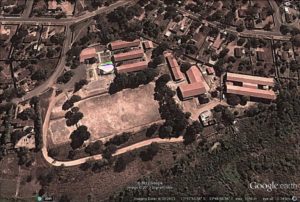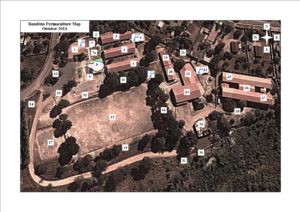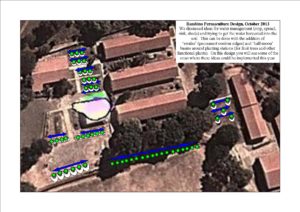
Over the years, Never Ending Food has received numerous requests from schools, organizations, and businesses to help them set up Permaculture ‘demonstration gardens’. Unfortunately, no such thing exists. Permaculture is a holistic ‘design’ system, which takes into account the entirety of the site being designed. Small areas can be converted to Permaculture practices, but these small areas need to be seen in relation to the ‘whole picture’. At school campuses, a good Permaculture Designer would begin with a process of ‘Observation‘. Observation is one of the most important parts of Permaculture design, and many people speak of Permaculture being comprised of about 80% observation and 20% implementation (or 100 hours of thinking for 1 hour of work). Good observation requires a thorough analysis of things that can be seen, heard, and smelled on the site. It also a directional orientation of where North, South, East and West are in relation to the site. This helps to determine sun and shade angles, wind direction, down-wind smells, dust problems, fire threats, and other ‘sector’ influences. It requires an investigation of seasonal changes in the climate, as well as the identification of micro-climates which may be found throughout the site. (A micro-climate may be influenced by the presence of water, shade, sun, structures, vegetation, etc.) Observation also takes into account soil and water considerations (e.g. is the soil healthy and soft or hard, infertile, and compacted; is there slope to the land that may influence the flow of water during rainy seasons; where does the water flow off of buildings, parking lots, or other structures, etc.). Designing requires a look at how the site is being used and accessed (e.g. what are the main activities taking place; where are the roads, footpaths, car-parks, streams, bridges, etc.; what are the main purposes of the buildings (homes, kitchens, school-blocks, bathrooms, toilets, storage areas, animal pens, etc.); what are the needs and desires of the stakeholders; are their future plans for expansion or changes to the site, etc.). Observation also needs to take an inventory of plant and animal species (e.g. trees, foods, natural medicines, fuel sources, seed-stock, insects, birds, wild and domestic animals, etc.)

When this process of observation has been undertaken (it is never actually ‘completed’, as observation is a continual process even during the implementation process), the next phase is to make a ‘map‘ of the site. This map should be a record of what is already existing on the site. Apart from the visible structures, don’t forget to take into consideration what is above and below (above may be electrical or telephone lines, and below may be water mains, gas lines, or underground cables). By mapping these existing resources to scale, it allows a good designer to then assess which areas can be improved in accordance with the needs trying to be met by the site.

The third stage is the ‘design‘. This is where the Designer begins to look at the site in terms of energy conservation. Through the use of Permaculture ‘Zones’, things that take more work can be located closer to the hubs of energy. For instance, if a home or classroom (Zone Zero) is using water for mopping, plants which like water can be located close to these sources. If there is a kitchen with left-over food scraps, things like compost bins, worm-farms, or kitchen gardens may be located in these areas (Zone One). The further away one moves from the sources of water and energy, the less water and energy should be required. In Zone Two, a designer may plan for orchards, small animal production, compost making, shade trees, windbreaks, etc. Zone Three becomes seasonal and rain-fed areas, where water-harvesting, staple foods, or larger animals may be located. Zone Four is generally comprised of managed woodlots and can be designed to meet the needs of fuel, building materials, income generation, animal grazing, fodder, food, bee-keeping, or even eco-tourism. Zone Five is the ‘forest’ where areas are allowed to regenerate naturally without much interference from humans. In agroecology, this is sometimes referred to as ‘rewilding’.
This process of observation, mapping, and design is the very same process that a person would use for a small home, a large farm, a community, or even a large urban area. The ‘Zones’ may be scaled up or down, but the thinking stays the same. On one site, a Permaculture Designer may identify or plan for multiple Zone Zeros, Ones, Twos, Threes, Fours, or Fives. Some Permaculture courses even teach about a ‘Zone Zero-Zero’, which is the human body. Without good nutrition, natural medicines, fresh air, clean water, etc., it is difficult for our bodies to implement the work required in the other Zones.
So, the next time you hear somebody asking about setting up a Permaculture ‘garden’, ask them if they’ve taken into consideration the ‘whole picture’.
